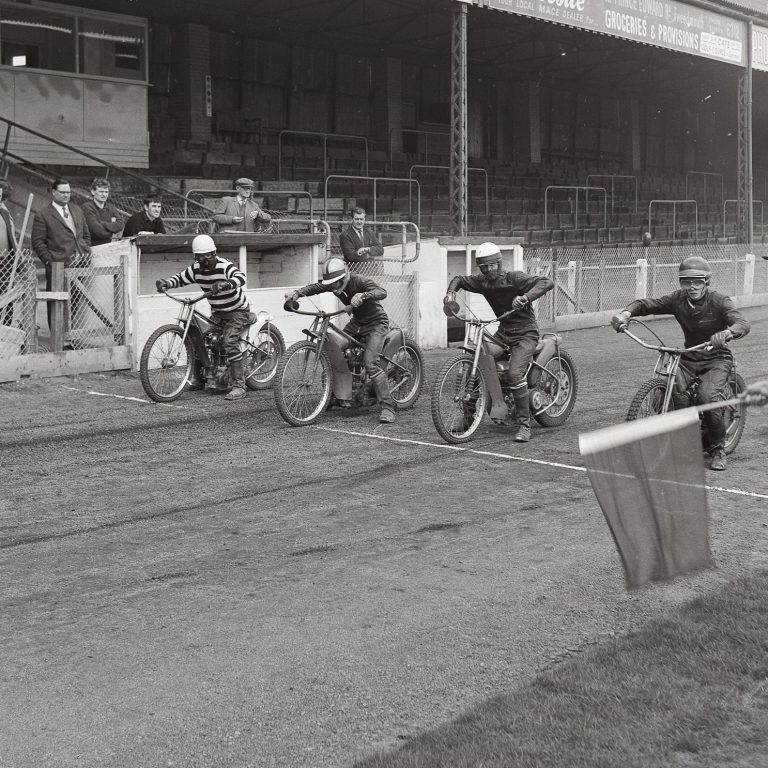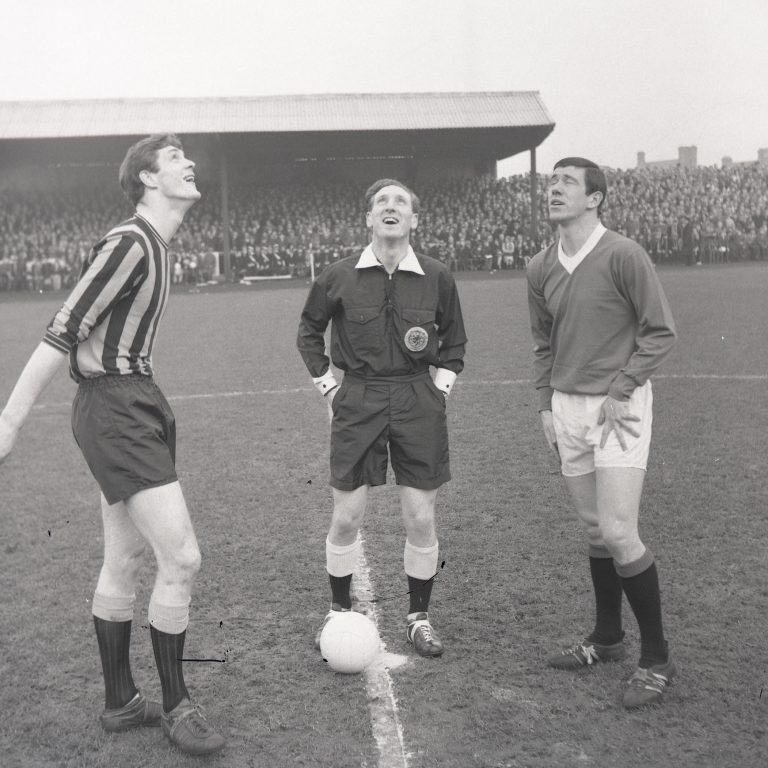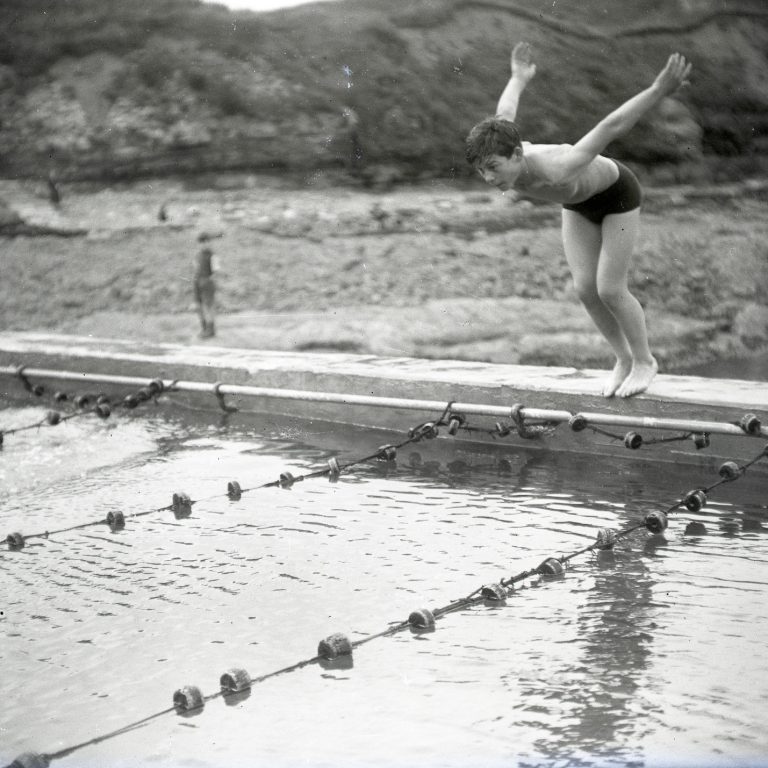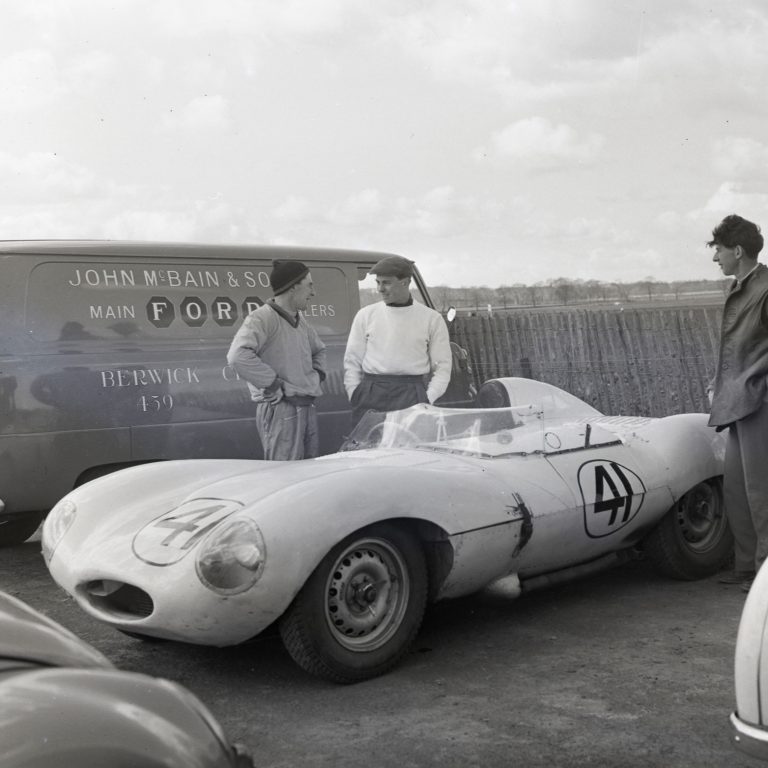Photographs of Sports in Berwick, 1960 -1968
Reference: BRO 1944/1/5015/7, BRO 1944/1/4720/4, BRO 1944/1/202/13,
BRO 1944/1/1939/9
Suggested age groups: KS2, KS3, KS4, KS5, Lifelong Learners
Topic areas: Photography, Sports, Journalism, Equality
CONTEXT
Originally founded in 1951 as the Photo-News Service, the Photo Centre in Berwick was a staple of town life for over 65 years as a family-run press agency and photo studio.
Their premises at 17 Bridge Street had a well-equipped studio above the shop where commercial photography took place. The business also covered newsworthy events in the area and recorded family occasions and celebrations, marking milestones in the lives of several generations of townspeople.
The first photograph (BRO 1944/1/5015/7) was taken on 27th April 1968 and shows speedway trials at Shielfield Park ahead of Berwick Bandits first competitive match which took place on 18th May against Newcastle Colts. JAP and JAWA bikes were the most popular models of this period.
The second photograph (BRO 1944/1/4720/4) was taken on 28th January 1967, also at Shielfield Park at the beginning of a football match between Berwick Rangers and Glasgow Rangers. The match became a famous 1-0 victory for Berwick Rangers. Captains Doug Coutts and John Greig are shown here in a coin-toss with referee Eddie Thomson.
The third photograph (BRO 1944/1/202/13) shows Berwick’s outdoor swimming pool in 1952. Until the opening of an indoor pool at the former Corn Exchange in 1972, Berwick only had this outdoor pool. It was sited at the Greenses beach, where there were separate ladies’ and gentlemen’s pools, the remains of which can still be seen.
The racetrack at Charterhall, on a former RAF airfield near Greenlaw in Berwickshire, was established in 1952, and Jim Clark won his first important race there in 1957. This final photograph (BRO 1944/1/1939/9) taken in 1958 shows Jim Clark with a D Type Jaguar, which he drove in 20 races that season, winning 12 of them. He went on to become a world-famous Formula One racing driver, winning two world championships. He was tragically killed at a race in Hockenheim in 1968, aged 32.
There are still many sports organisation in Berwick including the speedway, football, rowing, rugby, motor rallying, running and tennis. Many of these have their origins back in the late 19th and early 20th centuries whilst some are more recent. For example, Berwick Rowing Club was established in 1869 and Berwick Rangers Football Club in the 1880s whilst running and gymnastic clubs have only started since the building of the Sports Centre in the 1990s.
Berwick Rangers Football Club is unusual because although the club is geographically located in England, it has played in the Scottish leagues since 1905. Its high point was beating Glasgow Rangers at Shielfield Park in the Scottish Cup in 1967. The Club now plays in the Lowland Football League.
Berwick Bandits Speedway is also based at Shielfield Park and is a very popular spectator sport in North Northumberland and the Scottish Borders. It was established in 1968 and the team competes in the British Speedway Championships.
North Northumberland and the Scottish Borders has a long association with Motorsport on all levels – Jim Clark in Formula One and Louise Aitken Walker in rallying. Jim Clark was brought up in Berwickshire and competed in local car rallies at Charterhall and other former airfields in the area. Following his death, the Jim Clark Memorial Rally was started in 1970 and there is a museum in Duns, Berwickshire dedicated to his memory. The Photo Centre collections holds images of many events involving Jim Clark, including his homecoming after winning the World Championship in 1965. Louise Aitken Walker was a British rally and saloon car racing driver from Duns who became the first Ladies World Champion in 1990. She retired from the sport in 1993.
Sports photography is the genre of photography that covers all types of sports. In most cases, professional sports photographs are a branch of photojournalism. The photographs are taken for editorial purposes, with sports photographers working for newspapers, magazines or agencies photographing sporting events and sports personalities to report, record and promote key moments in the sporting world.
ARTISTS BANK
Neil Leifer
American photographer Neil Leifer is one of the most renown and recognisable sports photographers, having photographed some of the most iconic sporting moments of all time. He has had a prominent career, having photographed more than 150 covers for Sports Illustrated, as well as working for TIME magazine. He has also covered 32 of sports biggest events, including the Olympics, Wimbledon, Tour de France and the Super Bowl.
His photograph from the 1968 Summer Olympics of Team USA athletes Tommie Smith and John Carlos, 200 metre gold and bronze medallists, raising their fists in a black power salute on the medal podium during the US National Anthem captures one of the most significant sporting moments of the 20th century. Silver medallist Australian athlete Peter Norman also donned a human rights badge.
Example images: Julius Erving, 1977; Greg Louganis, 1988; Wilma Rudolph, 1962; Black Power Salute on Olympic Medal Stand, 1968
Richard Heathcote
Richard Heathcote has been described as one of the best sports photographers in the UK, having won many coveted awards including British Sports Photographer of the Year award at the 2019 British Sports Journalism Awards and the 2020 World Sports Photography Awards. Heathcote covers a large range of sports including the Olympics, FIFA World Cup, Rugby World Cup and The Ryder Cup.
Portfolio: http://www.richardheathcote.com/
Tom Jenkins
British photographer Tom Jenkins has been covering sporting events and sports personalities for over 30 years for The Guardian and The Observer. He has photographed five FIFA World Cups, four Summer Olympics, four Rugby World Cups, and 20 Wimbledon championships, to list but a few of his subjects.
Portfolio: https://tomjenkinsphoto.com/
Lynne Cameron
British photographer Lynne Cameron currently holds the position of official team photographer for the England women’s football team. She is formerly the official photographer of the Rangers FC and Scottish Rugby Union.
Portfolio: https://www.lynnecmrn.com/albums
Elsa Garrison
American photographer Elsa Garrison was the first female staff photographer at Getty Images. She has worked in sports photography since graduating from the University of Missouri in 1998. She has photographed both Summer and Winter Olympics, the Super Bowl, and NBA Finals. Her work has internationally been featured in publications such as The New York Times, TIME magazine, and Sports Illustrated.
Portfolio: https://www.elsagarrison.com/index
ACTIVITIES
ACTIVITY 1
Background
Neil Leifer’s photograph from the 1968 Summer Olympics of Team USA athletes Tommie Smith and John Carlos, 200 metre gold and bronze medallists, raising their fists in a black power salute on the medal podium during the US National Anthem captures one of the most significant sporting moments of the 20th century. Silver medallist Australian athlete Peter Norman also donned a human rights badge.
SEE
See: Which of Neil Leifer’s photographs shows one of the most significant sporting moments of the 20th century?
See: Who is shown in the photograph?
See: Which sporting event was the photograph taken at?
See: Which symbol did the subjects of the photograph make?
THINK
Think: Why is Tommie Smith and John Carlos making the black power salute on the medal podium significant?
Think: What was going on at the time in America in terms of race relations?
Think: What happened to Smith and Carlos’s careers after this moment?
Think: Can you think of any more recent moments in sporting history that had a similar message or impact?
Think: What does ‘equality’ mean?
Think: Is there equality in sports?
Think: How connected are sports and politics?
Think: Can you think of any moments in the recent past that showed an example of inequality in sports?
DO
Do: In groups, discuss what you think are the major issues of inequality in sports today.
Do: Discuss how closely tied issues of inequality in sport relate to inequality in society.
Do: Is there a way for these issues to be rectified? Discuss what changes would have to be made to make sports more inclusive.
Do: Major sporting events such as the Olympics claim to be politically neutral and have banned political expression and demonstrations. Discuss whether you think this is the right approach for sporting events and event organisers to make.
Do: Choose a significant moment from sporting history related to politics or inequality. Make a list of the events that inspired and led up to that moment.
Do: Make a second list of the positive changes and repercussions that the event caused.
Do: Write a journalistic exposure of what you perceive as the major issues in sports today. You could refer to events that highlight these issues.
Resources
https://www.theguardian.com/world/2012/mar/30/black-power-salute-1968-olympics
https://www.history.com/news/1968-mexico-city-olympics-black-power-protest-backlash
https://www.womeninsport.org/about-us/sexism-in-sport/
https://www.nytimes.com/2019/03/08/sports/women-sports-equality.html
https://www.vox.com/22585637/gymnastics-tokyo-olympics-2021-abuse-larry-nassar
ACTIVITY 2
Background
Sports photography is the genre of photography that covers all types of sports. In most cases, professional sports photographs are a branch of photojournalism. The photographs are taken for editorial purposes, with sports photographers working for newspapers, magazines or agencies photographing sporting events and sports personalities to report, record and promote key moments in the sporting world.
SEE
See: What types of sports are shown in the photographs?
See: What is sports photography?
See: What are the main purposes of professional sports photographs?
See: Where do most professional sports photographs appear?
THINK
Think: What are the characteristics of a successful sports photograph?
Think: Do these photographs match your criteria of a successful sports photograph?
Think: What should be shown in a sports photograph?
Think: What do you think is the purpose of each of these photographs?
Think: Where do you think these photographs might have appeared?
Think: Can a sports photograph show anything other than a sport being played? E.g. can the before and after moments of sporting events, promotional photographs of athletes, or photographs of audiences at sporting events be classed as sports photographs? How would you define them?
DO
Do: Make a spider diagram of everything that could be conveyed in a sports photograph, e.g. movement, narrative, pivotal moments, emotion, achievement, loss etc.
Do: Add to your spider diagram how/when/where you might capture each of the points listed.
Do: Research sports photographers and try to find one photograph for each of the points that illustrates what can be conveyed in a sports photograph.
Do: Analyse the techniques used by each photographer to obtain the shots from your spider diagram.
Do: Have a go at trying each of the techniques identified from each photograph.
Do: Plan your own sports photography shoot, including some of the areas and techniques you have been researching. Make a plan of what you want to convey, how you want to achieve this and what the intended purpose and audience is for the images.
Do: Complete your sports photography shoot.
Do: Analyse your images, did they meet your goals? If not, what could you change in future shoots?
Do: Complete any additional sports photography shoots to meet the goals you set yourself or adapt your plan to meet new goals.
Do: Choose a set of final images from your sports photography shoot. Mock up how you would display them to your intended audience, e.g. design a magazine editorial, design an exhibition space, design a billboard etc.
Do: Present your final images in the way you have chosen to display them.
Resources
OTHER ONLINE RESOURCES
Jim Clark Trust – https://jimclarktrust.com/
Early Photography
Science Museum website, page about history of photography: https://www.scienceandmediamuseum.org.uk/objects-and-stories/history-photography
British Library website, page about invention of photograph (Henry Fox Talbot): https://www.bl.uk/collection-items/invention-of-photography
Bodleian website, biography of Henry Fox Talbot: https://talbot.bodleian.ox.ac.uk/talbot/biography/
Photo Centre
Portrait of a Town exhibition: https://www.photocentreberwick.co.uk/portrait-of-a-town/work-and-industry
Photo Centre workshop resources: https://www.photocentreberwick.co.uk/learning
Sports Photography
Splento blog, history of sports photography – https://www.splento.com/blog/photography/the-art-of-sports-photography/
Page about camera settings for sports photography – https://www.photographymad.com/pages/view/the-perfect-camera-settings-for-action-and-sports-photography
Canon guide to sports photography – https://www.canon.co.uk/pro/stories/how-to-get-into-sports-photography/
Adobe guide to sports photography – https://www.adobe.com/uk/creativecloud/photography/discover/sports-photography.html
Sports Journalists Association – https://www.sportsjournalists.co.uk/category/photography/





